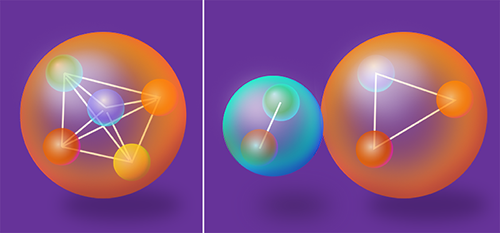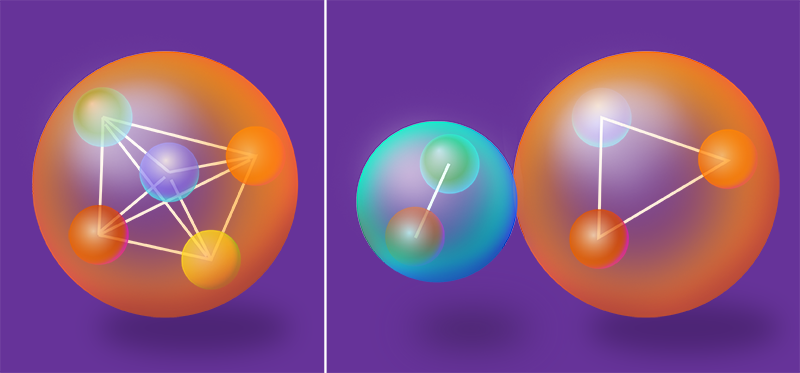Elusive Pentaquark Comes into View
The proton is made from three quarks, and mesons are made from a quark and antiquark. But what other configurations of quarks and antiquarks can form a particle? From a theoretical standpoint, this question is difficult to answer. Yet new particles with different combinations of quarks keep popping up in experiments. The latest of these, reported by the Large Hadron Collider Beauty (LHCb) Collaboration at CERN, is the pentaquark, a never-before-seen combination of five quarks that consists of a proton and a pair of heavy charm-anticharm quarks [1]. The detection of this particle comes as somewhat of a surprise: although the existence of the pentaquark doesn’t require a revision of the standard model of particle physics, earlier searches for a pentaquark composed of lighter quarks came up empty or detected candidate particles that could not be reproduced [2]. From studying this new form of quark matter, physicists stand to learn more about the complex forces between bound quarks.
The concept of multiquark particles is not new [3]. But for decades after the quark model was conceived, only two categories of strongly interacting particles were known: baryons (such as protons and neutrons), consisting of three quarks, and mesons. Only within the past decade have scientists started to observe new particles that do not fit into the quark model, such as the [4] and the (see 17 June 2013 Viewpoint), which are about 4 times heavier than the proton. The decays into a charm-anticharm meson (called the ), plus a light meson, suggesting the particle is made from two quarks and two antiquarks.
The observation of this four-quark state—or tetraquark—implied that other multiquark states, such as a heavy pentaquark, might exist [5]. The challenge has been looking for them. Rare particles are the proverbial needle in the haystack, as scientists must hunt for them in the copious debris from high-energy collisions. In the LHCb experiment, two protons collide at very high energy, sometimes producing composite particles that have a heavy bottom quark and which stay close to the beam line. The bottom-quark particles go a short distance and then decay into other particles, such as a pentaquark plus a meson, which are then picked up by a series of detectors. The key step that allowed LHCb’s detector to identify the candidate pentaquark was to only look for products of the bottom-quark particle , which has a lifetime long enough for it to move away from the proton-proton collision point before it decays. Using the decay as a filter, the researchers were able to see two new pentaquarks—or, rather, the products of their decays—sufficiently far from other confounding particle debris.
Both pentaquarks that LHCb has observed are resonant-energy states of the proton and the particle and are therefore referred to as “charmonium pentaquarks.” More formally, they are named and , where the numbers, according to convention, indicate the particles’ masses in mega-electron-volts.
A natural question to ask is what other combination of quarks—besides the resonant state of a proton and that the LHCb researchers assume—could form a pentaquark resonance? For example, over a decade ago, theorists predicted [6] that a pentaquark could be made from a proton and a meson—a pair of strange-antistrange quarks. But experimental searches never uncovered this type of pentaquark. Similarly, a resonant combination of the neutron and a meson, called the pentaquark, was predicted almost two decades ago. But again, the particle’s existence wasn’t confirmed, despite extensive experimental searches. (The exception was a claim by the Laser Electron Photon experiment in Japan that has been hotly contested [2].) In fact, there are many combinations of quarks that can form a pentaquark, but the only one seen so far is the charmonium pentaquark found by LHCb. What makes it so special?
The short answer is we don’t know. The forces between quarks are complex, and accurately describing a many-quark system using the theory of the strong force, quantum chromodynamics (QCD), is an extremely difficult problem. Researchers have made great progress using lattice gauge theory, which allows a numerical treatment of QCD, to determine the spectroscopy (resonant energy states) of strongly interacting particles [7]. Even with this approximation, however, theoretical calculations did not predict the LHCb pentaquarks. And in general, theory does not provide us with a good understanding of the heavy tetraquark particles [8].
Although predictions of the LHCb pentaquark were, before its discovery, vague at best, after-the-fact theoretical explanations have already started to appear [9]. In an attempt to interpret their data [1], the LHCb researchers conjecture that the pentaquark could be a tightly bound (spherical) system of all five quarks (Fig. 1, left), or a “molecular” system consisting of a weakly bound baryon and a meson (Fig 1, right). Many of the new theoretical models [9] are of the molecular type and involve a phenomenological meson-baryon force.
Without a reliable theory for many-body quark interactions, we are left to speculate on why the charmonium pentaquark exists but less-massive pentaquarks, made from light quarks, are not seen. One telling fact is that all of the known tetraquarks and pentaquarks decay into a particle plus other light mesons. It seems that the heavy charm quarks in the are, as theorists have already suggested, necessary to provide enough binding with light quarks to form multiquark states. According to the equations of QCD, the strong force is “flavor blind,” meaning that the force is the same regardless of whether a charm quark or a quark of a different flavor is involved. This implies that the property of the charm quark that allows it to bind multiquark states is its mass [10]. If so, we might expect that no pentaquarks can form from light quarks, but many combinations are possible with the charm quarks and the heavier bottom quark.
From studying pentaquarks and tetraquarks we will learn more about solutions to the many-body theory of QCD. LHCb’s discovery is an important stepping-stone in our understanding of the strong force, the least well known of the four forces in nature.
This research is published in Physical Review Letters.
References
- R. Aaij et al. (LHCb Collaboration), “Observation of Resonances Consistent with Pentaquark States in Decays,” Phys. Rev. Lett. 115, 072001 (2015).
- K. H. Hicks, “On the Conundrum of the Pentaquark,” Eur. Phys. J. H 37, 1 (2012).
- R. L. Jaffe, “Multiquark Hadrons I: Phenomenology of Mesons,” Phys. Rev. D 15, 267 (1977).
- S.-K. Choi et al. (Belle Collaboration), “Observation of a Narrow Charmoniumlike State in Exclusive Decays,” Phys. Rev. Lett. 91, 262001 (2003).
- S. J. Brodsky and R. F. Lebed, “QCD Dynamics of Tetraquark Production,” Phys. Rev. D 91, 114025 (2015).
- H. Gao, T.-S. H. Lee, and V. Marinov, “-N Bound State,” Phys. Rev. C 63, 022201 (2001).
- J. J. Dudek, R. G. Edwards, D. G. Richards, and S. J. Wallace, “Excited State Baryon Spectroscopy from Lattice QCD,” Phys. Rev. D 84, 074508 (2011).
- S. L. Olsen, “A New Hadron Spectroscopy,” Front. Phys. 10, 101401 (2015).
- See, for example, R. F. Lebed, arXiv:1507.05867 and references therein.
- T.E.O. Ericson and G. Karl, “Strength of Pion Exchange in Hadronic Molecules,” Phys. Lett. B 309, 426 (1993).





